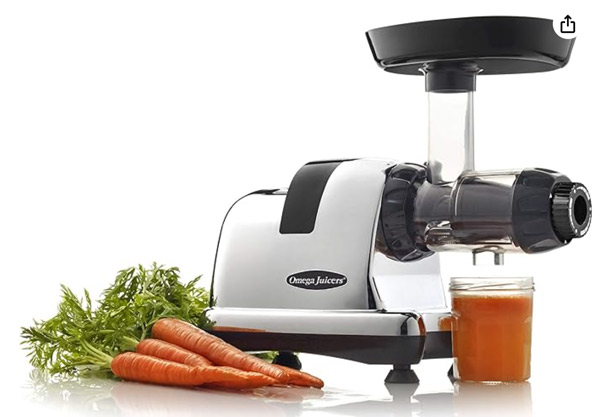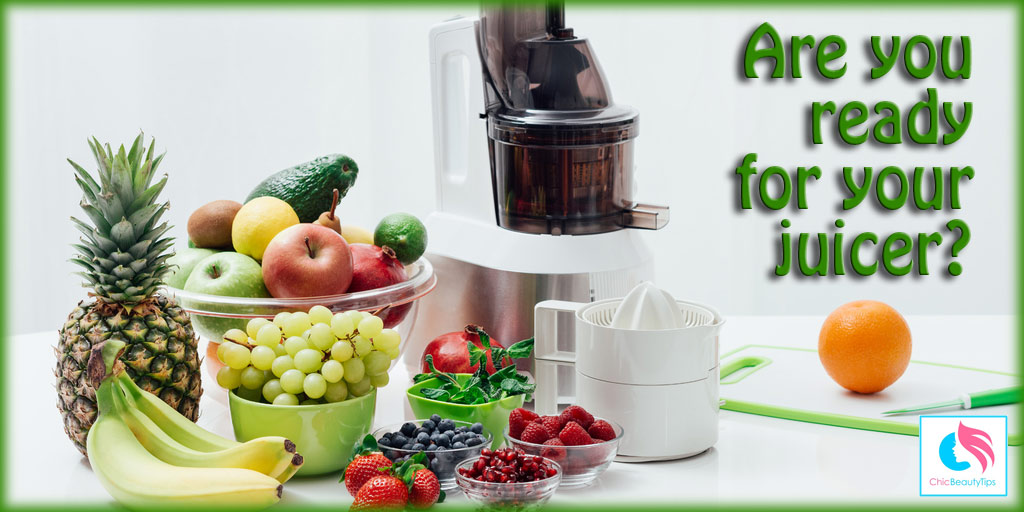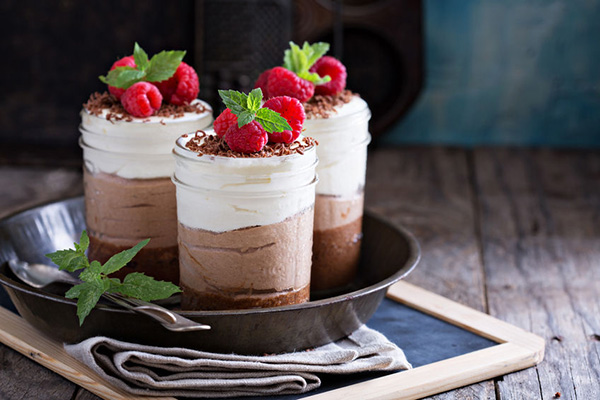Click to Tweet
Not all juicers are created equal. Nor are they meant for the same function. We are using them to increase our health and maybe a boost of energy.
For example, the masticating juicers tend to provide the boost of energy that we desire. Granted, this entire article has to do with that boost of energy, but it goes much deeper than that and the masticating juicer really excels in that area.
Introductory Thoughts on the Subject
I have to admit when I first heard the term, masticating I pictured some prehistoric Mammoth creature dripping with the remains of its recent meal and that was a bit more toward the turn-off than the side of learning more about it. But, pictures aside, I was ready for an education!
In our earlier articles, we referenced masticating and centrifugal types of juicers. But, we are going to dig a bit deeper and compare a few more types in this article.
But first, even though I set it aside, I had to resolve this picture thing, so I thought we could do it together ;).
Fortunately, I found a picture that is at least passable and cute by some standards. Yes, this critter or creature is masticating but then he (or she) does not have a blender or small kitchen appliance to do the work for him or her. So, for ingenuity and effort, I applaud our giraffe >>

Now, for the rest of us, we may want a machine to do it for us. Or, as the word should be, appliance. Not unless you want to go hire or adopt Mr. Giraffe to do it for you? (Does anyone know how to tell gender on these guys/gals… yes, a topic for another time and another site…) But, in the meantime, we can use Amazon to help us find something that looks good in our kitchen and probably is easier on the budget because we don’t have to feed it. Sorry, Mr. Giraffe.
 ?Larger Feed Chute?The larger feed chute supports you to cut less or put the whole fruit into the juicing, which can reduce your preparation time. At the same time, the safe rotary feed chute prevents hand entry, which is safer for children.1
?High Power Motor?300W high power motor can juice faster and more smoothly and reduce clogging. The juicer works at low speed and low noise, which will not disturb other people's rest and entertainment.1
?Larger Spiral Auger?3.2x6.3 inch (80x160mm) large spiral auger can grind the pulp more fully, reduce machine tangling and clogging, reduce bubbles production, and increase juice extraction rate by 30%.1
?Slag Juice Separation?Slow squeezing at 80 rpm, dregs and juice separation, reducing damage to the cell walls of fruits and vegetables. Less sediment, less oxidation, less nutrient loss, making the juice taste better and purer.1
?Easy to Clean?Simple and quick disassembly design. All parts of the juicer, except the motor base, can be washed with water and dishwasherable. With the complimentary brush can be cleaned more efficiently.1 *Product description quoted from amazon.
?Larger Feed Chute?The larger feed chute supports you to cut less or put the whole fruit into the juicing, which can reduce your preparation time. At the same time, the safe rotary feed chute prevents hand entry, which is safer for children.1
?High Power Motor?300W high power motor can juice faster and more smoothly and reduce clogging. The juicer works at low speed and low noise, which will not disturb other people's rest and entertainment.1
?Larger Spiral Auger?3.2x6.3 inch (80x160mm) large spiral auger can grind the pulp more fully, reduce machine tangling and clogging, reduce bubbles production, and increase juice extraction rate by 30%.1
?Slag Juice Separation?Slow squeezing at 80 rpm, dregs and juice separation, reducing damage to the cell walls of fruits and vegetables. Less sediment, less oxidation, less nutrient loss, making the juice taste better and purer.1
?Easy to Clean?Simple and quick disassembly design. All parts of the juicer, except the motor base, can be washed with water and dishwasherable. With the complimentary brush can be cleaned more efficiently.1 *Product description quoted from amazon.Disclaimer: I have picked up some interesting appliances before, during, and I’m sure after this series, but I have not used these particular appliances linked in this article… yet. Please be sure to reference the customer reviews when it comes to specific models, etc.
Another term that you may have heard, for masticating juices, may be cold-press juicers. It tends to have that chunkier juice style. Then again, we don’t exactly refer to it as “chunkier” do we. For you mothers with babies, that isn’t what we want to associate with juice… ok, I’ll stop 🙂
Maybe a better picture is that old Minute Maid commercial… I couldn’t find the old one I was thinking of but found another one that I think will help illustrate the point 😉 Oh, and Minute Maid isn’t paying me or giving me any incentives or anything to mention them. Hopefully they don’t mind me sharing their YouTube. Minute Maid – you will let me know if you want me not to share your YouTube, right?
As you can see, and especially with the Minute Maid example, there are definitely different sorts of juicers. We’ll talk about the citrus version, which is going to be a bit less expensive but also a bit less “hearty” and we will talk about the centrifugal version, that falls sort of in between the two. As you can imagine, those juicing addicts or aficionados, tend to prefer the masticating kind of juicers and that makes sense, as they are seriously into their juice (and making it)! But, that is no reason that you cannot check out the other kind(s). No one said you have to follow the pack, right?
The advantages of masticating (over some of the other juicer types):
- More nutrients stay in the juice because there is less oxidation in the masticating juice process, by intentional design (and oxidation occurs in other juicer types).
- Depending on the model, it can sometimes pinch hit for your food processor!
- Sometimes it is helpful to not have those swollen feet or legs (especially as we age!) and there are anti-inflammatory benefits that come with juice like this. It has also been said to help with heart disease and cancer and generally helps with good health.
- The natural sugar (a.k.a. carbohydrate) helps to provided needed energy, whether you are cleaning out the garage today or ready to go for your daily workout.
Some possible concerns to keep in mind:
- Juice will lose the benefit of those nutrients when left out to sit (makes sense because all the benefits of less oxidation are now replaced by exposure to oxygen) – drink sooner than later!
- Even if it can double for some tasks of the food processor, it is not a food processor and you shouldn’t put large pieces of anything in it. Sure, it may work, but it also may take forever 🙂
How To Use Your Masticating Juicer:
- Feed the pieces (remember, not tooooo large) into the appliance and turn it on and watch it go.
- The juice goes one place and the food (pulp) goes another. Recombine them if you like your juice to have that bit of pulp in it.
- Consider using fruits and veggies such as spinach, pineapple, green apples, celery, lemon, and cucumbers. Combine them all together, add some ginger, and you have a refreshing, healthy, immune-boosting (hopefully) drink!
Click to Tweet
 ??Wide & Dual Feed Chute?- Aeitto vertical juicer with 3.3 inch(83mm) large feed chute easily accepts larger pieces of fruits and vegetables and smaller feed chute for strip shape ingredients. It's perfect for the whole fruit and long vegetables. Greatly reduces preparation and cleanup time. Less chopping of the ingredients also helps to reduce oxidation.
??Higher Nutrition?- At low speeds of 47-60 RPM minimizing heat build-up and oxidation. Over 90% Nutrition and 70% vitamins are well preserved. The cold pressed juicer machine will reserves the vitamins, enzymes, minerals, trace minerals and nutrients with less heat and friction. Less foaming and no clogging.
??Juice & Pulp Separation Function?- The Aeitto Juicers perfectly separates the pomace from the juice, and extracts the nutrients with less oxidation. 900ml juicer cup & pulp cup can serve your daily demand. Now you can enjoy the purest juice from apple, ginger, celery, carrot, kale or vegetables.
??Baby Health And Silent?- The slow masticating juicer extracts less than 60 decibels. BPA-Free material, easy to assemble and operate, and easy to clean with equipped brush which let you enjoy a quiet life.
??Warranty Service & Brand Story?- We provide a 30-Days money-back guarantee and 12 months of warranty services for the slow masticating juicer. The Aeitto Juicer Machine provides 7*24 hours of contact service. Please feel free to contact us if products have any problems. Aeitto specializes in providing buyers with high-quality small appliance products and the best user experiences. *Product description quoted from amazon.
??Wide & Dual Feed Chute?- Aeitto vertical juicer with 3.3 inch(83mm) large feed chute easily accepts larger pieces of fruits and vegetables and smaller feed chute for strip shape ingredients. It's perfect for the whole fruit and long vegetables. Greatly reduces preparation and cleanup time. Less chopping of the ingredients also helps to reduce oxidation.
??Higher Nutrition?- At low speeds of 47-60 RPM minimizing heat build-up and oxidation. Over 90% Nutrition and 70% vitamins are well preserved. The cold pressed juicer machine will reserves the vitamins, enzymes, minerals, trace minerals and nutrients with less heat and friction. Less foaming and no clogging.
??Juice & Pulp Separation Function?- The Aeitto Juicers perfectly separates the pomace from the juice, and extracts the nutrients with less oxidation. 900ml juicer cup & pulp cup can serve your daily demand. Now you can enjoy the purest juice from apple, ginger, celery, carrot, kale or vegetables.
??Baby Health And Silent?- The slow masticating juicer extracts less than 60 decibels. BPA-Free material, easy to assemble and operate, and easy to clean with equipped brush which let you enjoy a quiet life.
??Warranty Service & Brand Story?- We provide a 30-Days money-back guarantee and 12 months of warranty services for the slow masticating juicer. The Aeitto Juicer Machine provides 7*24 hours of contact service. Please feel free to contact us if products have any problems. Aeitto specializes in providing buyers with high-quality small appliance products and the best user experiences. *Product description quoted from amazon.Snack Without Guilt - Your taste buds have never had it so good! 100 Healthy Raw Snacks & Treats (affiliate link) is the definitive guide to good-tasting snack foods that only sound like they are fattening.
You have probably seen those fancy juice bars with their cold-pressed concoctions and wondered if you could replicate that at home. Maybe you got a juicer as a gift but it’s still sitting in the box because you have no idea how to use it. Or perhaps you want to start juicing for better health but feel overwhelmed by all the options. Don’t worry, we’ve all been there as juicing newbies. This article will walk you through everything you need to know about juicers as a beginner. You’ll learn the different types of juicers, what to juice, how to use your machine properly, and tips for getting the most out of it. Juicing is intimidating but doesn’t have to be – let us demystify it and help you become a pro!
Choosing the Right Masticating Juicer for Your Needs
Know Your Budget
A good masticating juicer can cost between $200 to $500. Consider how much you want to invest based on how often you plan to juice. For occasional use, an affordable model around $200-$300 should work great. If you want to juice daily, invest in a high-quality juicer for the best results and durability.
Consider Your Counterspace
Masticating juicers come in a range of sizes. Make sure you have enough room on your counter for the juicer base, and consider where you’ll store attachments. More compact, vertical masticating juicers are great for small spaces, while horizontal models typically have a larger footprint.
Think About What You Want to Juice
Masticating juicers can handle almost any fruit or vegetable, but some are better for juicing leafy greens and wheatgrass. If you plan to juice a lot of greens, look for a juicer specifically designed for that.
Greens do not tend to be as “juicy” as fruits so you may want to consider combining them (blending them) in recipes such as smoothies, etc. You can find truly creative ideas. Another idea would be soups and stews, taking it beyond the traditional “juicing” concept but still using your basic juicing machine.
 SIMPLE IS BEST, ORIGIN IS BEST-Simply press the orange, the juice is much more tasty! This electric orange squeezer extract juice with slow speed system, which don't heat up the juice and preserve vitamins, enzymes and other nutrients. The electric orange juicer provides the pure taste of fruit
UNIQUE DESIGN-This electric juicer for oranges designed with more powerful and quiet motor, work with updated gear system and stable base, makes less noise and no swagging during operation. On the top there is a flower shaped container with filter to prevent the splash and keep the juice
AUTO-FLOWING SPOUT-The electric lemon squeezer has a flexible spout. If you want the juice flowing to cups automatically, just press down the spout. If cups are not ready on the table, just lift the spout, and the juice stored well in "flower" container
EAST OF USE AND CLEANING-The juice extractor is assembled by several parts, all detachable for easy separating and cleaning. All components are dishwasher safe except the motor base. A special multi-purpose cone is also washable and suitable for most citrus fruit
COMPLY WITH FDA This juicer machine use environmental materials, comply with FDA, NO BPA. The orange juice maker provide a 12-months guarantee *Product description quoted from amazon.
SIMPLE IS BEST, ORIGIN IS BEST-Simply press the orange, the juice is much more tasty! This electric orange squeezer extract juice with slow speed system, which don't heat up the juice and preserve vitamins, enzymes and other nutrients. The electric orange juicer provides the pure taste of fruit
UNIQUE DESIGN-This electric juicer for oranges designed with more powerful and quiet motor, work with updated gear system and stable base, makes less noise and no swagging during operation. On the top there is a flower shaped container with filter to prevent the splash and keep the juice
AUTO-FLOWING SPOUT-The electric lemon squeezer has a flexible spout. If you want the juice flowing to cups automatically, just press down the spout. If cups are not ready on the table, just lift the spout, and the juice stored well in "flower" container
EAST OF USE AND CLEANING-The juice extractor is assembled by several parts, all detachable for easy separating and cleaning. All components are dishwasher safe except the motor base. A special multi-purpose cone is also washable and suitable for most citrus fruit
COMPLY WITH FDA This juicer machine use environmental materials, comply with FDA, NO BPA. The orange juice maker provide a 12-months guarantee *Product description quoted from amazon.Some models also come with attachments for making nut milk, baby food, and sorbets. Consider any special features that are important to you.
Compare Motor Power
More powerful motors, typically classified as “slow” or “twin gear” masticating juicers, can generate higher yields, especially from dense vegetables. They run at lower RPMs, around 60 to 80, to minimize oxidation. For most needs, a motor in the 200 to 250-watt range is perfectly capable. Higher wattages, up to 400 watts, are better for frequent, high-volume juicing.
Check the Warranty
A good warranty is important for any kitchen appliance. Look for a masticating juicer that offers at least a 1-year limited warranty. Longer warranties, 3 to 5 years, usually indicate a high-quality, durable product. Make sure the warranty covers the motor, parts, and any accessories.
Final Thoughts on Choosing the Masticating Juicer
If nutrition is your top priority, a masticating or slow juicer is superior to a centrifugal juicer. Masticating juicers use a cold-press method that generates less heat, resulting in more live enzymes and nutrients in your juice. Juice from a masticating juicer can also be stored longer, up to 3 days.
Choosing the Right Citrus Juicer for Your Needs
So you’ve decided to take the plunge into homemade citrus juice – excellent choice! Now it’s time to find a juicer that fits your needs and budget.
### Types of Citrus Juicers
The two most common types are centrifugal juicers and masticating juicers. Centrifugal juicers are faster but can be louder and produce more froth. Masticating juicers are quieter and yield more juice, but at a slower speed. For citrus, a centrifugal model works great and is very affordable.
Size and Capacity
Think about how much juice you want to make at once. For a small family, a 2-quart model should do the trick. If you plan to juice for a crowd, go bigger. Some juicers can handle several pieces of fruit at once for higher volume.
Ease of Use and Cleaning
Look for a juicer that is simple to assemble, operate, and take apart for cleaning. Choose dishwasher-safe parts when possible. A juicer with only a few components will be easier to clean than one with many small pieces.
Additional Features
Some useful extras include:
•Pulp control – Adjustable to your desired pulp level.
•Non-skid feet – Keeps the juicer stable on your countertop.
•Cord storage – Keeps your countertop tidy.
•Interchangeable parts – For citrus and other fruits. Multi-purpose is convenient.
Keep in mind, even if it seems like a slow speed or a masticating slow juicer, do not worry; patience is a virtue, and if you are using the juicer according to its instructions, you are on the right path!
Recommended Citrus Juicers
For beginners, a simple centrifugal model like the Cuisinart CCJ-500 Pulp Control Citrus Juicer or Hamilton Beach 67608A Juicer are great starter machines that won’t break the bank. When you’re ready to upgrade, a high-quality masticating juicer like the Omega J8006HDS Nutrition Center Juicer is an excellent choice.
Whatever you choose, happy juicing! Fresh homemade citrus juice is worth it.
 SUPERIOR FUNCTION: Our sleek brushed stainless steel Pulp Control Citrus Juicer gets out more juice more efficiently
MUST-HAVE FEATURES: Adjustable reamer with 3 pulp control settings-low, medium, high with auto-reversing universal juicer cone for more efficient juicing
ADDITIONAL FEATURES: Final-Spin feature extracts more juice from pulp and protects against dust including an extra-long snap-up spout that accommodates more glasses and prevents drippings
CONVENIENT: Juicing Cone accommodates small limes to large grapefruits, cord storage and easy-clean dishwasher safe parts
LIMITED 3-YEAR WARRANTY: Refer to user manual for troubleshooting steps and questions surrounding warranty policies – this product is BPA free *Product description quoted from amazon.
SUPERIOR FUNCTION: Our sleek brushed stainless steel Pulp Control Citrus Juicer gets out more juice more efficiently
MUST-HAVE FEATURES: Adjustable reamer with 3 pulp control settings-low, medium, high with auto-reversing universal juicer cone for more efficient juicing
ADDITIONAL FEATURES: Final-Spin feature extracts more juice from pulp and protects against dust including an extra-long snap-up spout that accommodates more glasses and prevents drippings
CONVENIENT: Juicing Cone accommodates small limes to large grapefruits, cord storage and easy-clean dishwasher safe parts
LIMITED 3-YEAR WARRANTY: Refer to user manual for troubleshooting steps and questions surrounding warranty policies – this product is BPA free *Product description quoted from amazon. MAKE FRESH HEALTHY JUICE IN SECONDS: Transform whole fruits and vegetables into nutritious juice in seconds with this fruit and vegetable juicer. The stainless steel micromesh filter strains away pulp and seeds for smooth, nutritious juice every time.
SAVE TIME & EFFORT: The extra-large 3 inch Big Mouth chute on the fruit juicer lets you easily add whole foods without precutting. This reduces prep time to save time and effort in the kitchen.
MAXIMUM JUICE YIELD: Juice everything from dense beets to leafy greens. The powerful 800 watt motor and stainless steel strainer on the juice extractor ensure maximum juice yield, less waste and more flavor. The simple on/off dial is easy to use.
EASY TO CLEAN: Cleaning up after you juice is easy. The juice extractor comes with a convenient strainer cleaning brush, and the juicing cup, pulp bin, juice bowl, lid and pusher are all dishwasher safe.
INCLUDES A 3 YEAR LIMITED WARRANTY: This durable fruit and juice machine is backed by Hamilton Beach, America's #1 juice extractor brand,* with a 3 year limited warranty. *Product description quoted from amazon.
MAKE FRESH HEALTHY JUICE IN SECONDS: Transform whole fruits and vegetables into nutritious juice in seconds with this fruit and vegetable juicer. The stainless steel micromesh filter strains away pulp and seeds for smooth, nutritious juice every time.
SAVE TIME & EFFORT: The extra-large 3 inch Big Mouth chute on the fruit juicer lets you easily add whole foods without precutting. This reduces prep time to save time and effort in the kitchen.
MAXIMUM JUICE YIELD: Juice everything from dense beets to leafy greens. The powerful 800 watt motor and stainless steel strainer on the juice extractor ensure maximum juice yield, less waste and more flavor. The simple on/off dial is easy to use.
EASY TO CLEAN: Cleaning up after you juice is easy. The juice extractor comes with a convenient strainer cleaning brush, and the juicing cup, pulp bin, juice bowl, lid and pusher are all dishwasher safe.
INCLUDES A 3 YEAR LIMITED WARRANTY: This durable fruit and juice machine is backed by Hamilton Beach, America's #1 juice extractor brand,* with a 3 year limited warranty. *Product description quoted from amazon. Cold Press Slow Juicer: This juice maker machine operates at a slow 80 RPM to minimize heat buildup and oxidation, promoting maximum nutrient extraction and healthy enzymes.Product care instructions: Hand Wash Only
Versatile Kitchen Tool: Turn nuts into nut butter, extrude pasta, grind coffee and spices, mince herbs and garlic, make baby food and frozen desserts, and quickly whip up soy milk with the help of this versatile electric juicer and nutrition system
Max Flavor and Nutrients: This fruit juicer machine uses triple-stage masticating technology to extract the maximum amount of nutrients, vitamins, flavor and juice from minimal amounts of fruits, vegetables, leafy greens and wheatgrass
Adjustable End Cap: Features 3 pressure settings designed to ensure maximum juice output and extraction; An automatic pulp ejection system allows you to enjoy continuous juicing
Easy To Use: Equipped with a powerful but quiet gear reduction equivalent to a 2HP motor, this juice maker generates enough torque to process tough ingredients; Also features an extra-large feed tray and convenient built-in handle *Product description quoted from amazon.
Cold Press Slow Juicer: This juice maker machine operates at a slow 80 RPM to minimize heat buildup and oxidation, promoting maximum nutrient extraction and healthy enzymes.Product care instructions: Hand Wash Only
Versatile Kitchen Tool: Turn nuts into nut butter, extrude pasta, grind coffee and spices, mince herbs and garlic, make baby food and frozen desserts, and quickly whip up soy milk with the help of this versatile electric juicer and nutrition system
Max Flavor and Nutrients: This fruit juicer machine uses triple-stage masticating technology to extract the maximum amount of nutrients, vitamins, flavor and juice from minimal amounts of fruits, vegetables, leafy greens and wheatgrass
Adjustable End Cap: Features 3 pressure settings designed to ensure maximum juice output and extraction; An automatic pulp ejection system allows you to enjoy continuous juicing
Easy To Use: Equipped with a powerful but quiet gear reduction equivalent to a 2HP motor, this juice maker generates enough torque to process tough ingredients; Also features an extra-large feed tray and convenient built-in handle *Product description quoted from amazon.Choosing the Right Centrifugal Juicer for Your Needs
So you’ve decided to take the plunge into the world of juicing—congratulations! The first step is choosing a centrifugal juicer that suits your needs and budget. Centrifugal juicers come in a range of sizes, speeds, and price points. Here are some factors to consider:
Speed
Faster is not always better when it comes to centrifugal juicers. Higher speeds can heat up the juice and oxidize nutrients. For most people, a juicer with a speed between 5,000 to 15,000 RPM will work great. Slower speeds are better for leafy greens and wheatgrass. Faster speeds are better for hard fruits like beets and carrots.
Feed Chute Size
A larger feed chute means less chopping of fruits and veggies before juicing. A 3-inch feed chute can handle whole apples and beets. A smaller chute requires more prep work but can produce a higher juice yield. Consider how much time you want to spend prepping produce.
Ease of Cleaning
Look for a juicer with parts that are dishwasher safe and easy to disassemble and reassemble. A juicer with fewer parts will be quicker to clean. Some models have built-in brushes to clean the mesh filter. Check reviews to see what owners say about the cleaning process.
Additional Features
Some useful extras to consider include:
- Adjustable pulp ejection: Allows you to control how much pulp ends up in your juice.
- Reverse function: Helps unclog the juicer and improves juice yield.
- Non-slip feet: Keeps the juicer stable on your countertop.
- Pulp container: Collects separated pulp for compost or other uses.
- Limited warranty: Gives you coverage if parts need repair or replacement.
By evaluating the factors that matter most to you like speed, size, ease of use, and budget, you’ll find a centrifugal juicer that you’ll love using every day. Once you start experiencing all the benefits of fresh-squeezed juice, you’ll be glad you took the time to choose a juicer that perfectly fits your needs.
Storing Juice and Getting the Most Nutrition
Once you’ve made your juice, proper storage is key to maintaining maximum nutrition. Freshly squeezed juice can lose nutritional value quickly due to oxidation, so drink it within 24 hours of juicing for the biggest nutritional punch.
Keep it Cool
As soon as possible after juicing, refrigerate your juice. Cold temperatures slow down oxidation and enzymatic activity that can degrade nutrients. An airtight container, like a glass jar or bottle, is best. This prevents exposure to oxygen and helps keep your juice fresher for longer.
Limit Air Exposure
When juicing, fill your airtight container to the top to limit air space. Once refrigerated, avoid opening the container frequently which exposes the juice to more oxygen. If there are leftovers, pour into smaller airtight containers so there’s no headspace and less surface area exposed to air.
Consider Freezing
For longer-term storage up to 3 months, consider freezing your juice in ice cube trays or muffin tins. Once frozen, pop out the cubes and store them in an airtight bag or container in the freezer. When ready to drink, simply add 3-4 cubes to a glass of water or juice. Freezing does reduce some nutrition, but it is better than not drinking the juice at all!
Add Lemon or Lime
The citric acid in lemon or lime juice helps prevent oxidation and acts as a natural preservative. For every 4 ounces of juice, add the juice from half a lemon or lime. The vitamin C in citrus is also beneficial. Stir to combine and then refrigerate as usual.
By following these tips, you’ll be able to enjoy the nutritional benefits of fresh juice for days after making it. Bottoms up to better health!
Troubleshooting Common Juicer Problems
Motor Overheating
The motor is the heart of your juicer, so overheating can significantly impact performance and longevity. Several things can cause the motor to overheat:
Too much produce at once: Don’t overload the feed chute. Add produce gradually to allow the juicer time to juice everything efficiently. Take breaks if needed between additions.
Stringy or leafy greens: Certain produce like kale, spinach, and celery can wrap around the auger, straining the motor. Alternate these greens with other produce or juice them in smaller batches.
Dull auger: An auger that is not sharp will require the motor to work harder to produce juice. Consider replacing your auger if it’s visibly dull or you notice a decrease in performance.
To prevent motor overheating, run your juicer in short “on” bursts, not continuously. Allow 15-30 minutes between uses for the motor to cool if overheating occurs. Following the manufacturer’s recommendations for produce amounts and types will also help prevent excess strain on the motor.
Leaking or Spitting
If your juicer is leaking, spitting or ejecting pulp, a few issues could be the culprit:
Overfeeding: Adding too much produce at once will back up the juicer and cause leaks or spitting. Slow down the feeding rate and allow the juicer time to juice before adding more.
Misaligned or damaged parts: The feed chute, pulp ejection chute, or juicing screens could be askew or damaged, allowing pulp and juice to escape. Inspect all parts for damage and replace or realign as needed.
Pulp overload: If the pulp container fills up, the excess pulp has nowhere to go and will spit out of the juicer. Empty the pulp container regularly when juicing large amounts.
Loose or damaged seal: A loose seal around the auger or at the base of the feed chute can allow pulp and juice to leak during operation. Inspect all seals and gaskets to ensure they are properly fitted and undamaged. Replace if needed.
Following the correct assembly instructions and not overfeeding the juicer are the best ways to prevent leaks and spitting. Inspecting components regularly will help identify any damage early on as well. By properly troubleshooting common issues, you’ll get many years of healthy juice from your machine.
FAQs: Answering Your Top Juicer Questions
What types of juicers are there?
The two main types are centrifugal juicers and masticating juicers. Centrifugal juicers spin at high speeds to extract juice, while masticating juicers slowly crush produce to squeeze out juice. Masticating juicers tend to be more expensive, but produce higher quality juice. The type you choose depends on your needs and budget.
How much juice can I expect from different fruits and veggies?
The amount of juice you’ll get depends on the water content and density of the produce. For example, you can expect a good amount of juice from oranges, apples, and cucumbers which are mostly water. Leafy greens and carrots will yield less juice. As a general rule, you’ll need:
•3-5 oranges to make 16 ounces of juice
•2-3 apples to make 16 ounces
•1 cucumber to make 8 ounces
•1 pound of carrots to make 8 ounces
•1/2 pound of kale to make 8 ounces
Do I need to peel the produce before juicing?
For the most part, you do not need to peel fruits and vegetables before juicing. The peels contain many nutrients. However, some peels like oranges, bananas and avocados should be removed. Pineapple skin should also be removed. Make sure to wash all produce thoroughly before juicing.
How long will homemade juice last?
Homemade juice should be consumed immediately for the best quality and nutrition. However, juice can last 2 to 3 days when properly refrigerated. To maximize freshness:
• Make juice in small batches so you can drink it quickly.
• Fill the juice container to the very top to minimize oxygen exposure.
• Seal the container tightly and refrigerate immediately.
• The longer juice sits, the more nutrients it loses. For the best nutrition, drink juice within 24 hours of making it.
Can I juice the same day I buy produce?
For maximum nutrition and flavor, it is best to juice produce within a few days of purchasing. However, if you wash and thoroughly dry the produce, juicing it the same day you buy it, it will be fine. When produce sits for too long, it loses nutrients, and the juice may become bitter. If possible, buy produce specifically for juicing 2-3 times a week.
Juicing is a convenient way to add more fruits and vegetables to your diet. With the right juicer and some fresh produce, you’ll be well on your way to better health in no time! Let me know if you have any other questions about juicing.
What are the disadvantages of a masticating juicer?
Masticating juicers, also known as slow juicers or cold press juicers, have a number of disadvantages compared to centrifugal juicers. These juicers operate at a slower speed, which means they take longer to extract juice from fruits and vegetables. The slow masticating juicer also has a tendency to clog more easily, especially when juicing harder items like carrots. This can be frustrating to deal with, as it can slow down the juicing process significantly. In addition, masticating juicers tend to be more expensive than centrifugal juicers, which may be a deterrent for some consumers. Overall, while the juice produced by a masticating juicer is often more nutritious and full of flavor, the downsides of a slower juicing process and potential clogging issues may outweigh the benefits for some people.
What is the difference between a slow juicer and a normal juicer?
Slow juicers, also known as cold press juicers or masticating juicers, operate at a much slower speed compared to traditional centrifugal juicers. Instead of using a fast-spinning blade to grind fruits and vegetables to extract juice, slow juicers use a rotating auger to slowly crush and grind the produce. This gentle process separates the juice from the pulp, resulting in a more nutritious juice that retains more vitamins and enzymes. Cold press juicer machines are also able to extract more juice out of the pulp, as they are able to effectively squeeze out every last drop. They are also better at handling fibrous fruits and vegetables, like carrots, since the slower grinding process is able to extract juice even from tough produce.
When it comes to cleaning, slow juicers, like the spiral masticating model from Ninja, are often easier to clean than traditional juicers. With a fine mesh that separates the juice from the pulp and a reverse button to help clear any clogs, cleaning a slow juicer is a breeze. The Ninja Juicer Pro even comes with a cleaning brush to make sure every nook and cranny is spotless. If you are looking to upgrade your juicing routine and enjoy a glass of fresh, nutritious juice every day, be sure to subscribe to our channel for more tips and tricks on using a slow juicer.
 Cold Press Technology that produces more juice*, less foam, and brighter colors than leading centrifugal juicers.** *Per pound of produce. **Yield may vary by season.
2 one-touch programs for simple use - Start/Stop and Reverse.
Simple assembly makes for no-hassle setup and cleaning.
Cleaning brush included for those hard to reach areas.
Compact size makes it easy to store or fit under cabinets.
Includes: 150-watt motor base with stainless steel auger, (3) interchangeable pulp filters for total control, (1) 16oz. Juice jug, Large pulp container, (1) Cleaning Brush & Inspiration Guide with 10 recipes. Cord length (in.): 31.5 in. *Product description quoted from amazon.
Cold Press Technology that produces more juice*, less foam, and brighter colors than leading centrifugal juicers.** *Per pound of produce. **Yield may vary by season.
2 one-touch programs for simple use - Start/Stop and Reverse.
Simple assembly makes for no-hassle setup and cleaning.
Cleaning brush included for those hard to reach areas.
Compact size makes it easy to store or fit under cabinets.
Includes: 150-watt motor base with stainless steel auger, (3) interchangeable pulp filters for total control, (1) 16oz. Juice jug, Large pulp container, (1) Cleaning Brush & Inspiration Guide with 10 recipes. Cord length (in.): 31.5 in. *Product description quoted from amazon.What is the difference between a masticating juicer and a centrifugal juicer?
Centrifugal juicers and masticating juicers are two popular types of juice extractors that have different methods of extracting juice from fruits and vegetables. Centrifugal juicers work by using a high-speed spinning blade to quickly chop up the produce and extract the juice. This can result in a lot of foam in the finished juice and a higher amount of pulp. On the other hand, masticating juicers use a slower process of crushing and pressing the produce to extract the juice. This method produces a higher-quality juice with less foam and a lower amount of pulp. Additionally, masticating juicers are easy to assemble and disassemble, making them easy to clean. If you enjoy carrot juice or other whole fruits in your beverage, a masticating juicer may be a great option for you.
How do I find the best masticating juicer on the market?
Are you on the hunt for the best masticating juicer on the market but feeling overwhelmed by the choices available? Look no further, as we have the perfect solution for you. When it comes to choosing between centrifugal and masticating juicers, it’s essential to consider the quality of juice and pulp produced. With a masticating juicer, you can expect to get the most wholesome and high-quality juice with minimal oxidation. Often, you can Google YouTube videos and look at the transcripts to read what is said in the video and to learn about the juicers.
Not only are masticating juicers quieter, typically running at 60 decibels, but they also come with safety locks and separate containers for easy disposal of pulp. Plus, with a slower per-minute speed, you may receive a small commission for every drop of juice. Don’t wait any longer. Upgrade your juicing game and say hello to high-quality juice with a masticating juicer! But don’t feel pressured; get the juicer that is right for you because it is about health and what works for you and your lifestyle.
Conclusion
At the end of the day, using a juicer is as simple as tossing in your favorite fruits and veggies and letting the machine work its magic. With some trial and error, you’ll be whipping up nutrient-packed juices in no time. The key is to start with simple recipes, get a feel for prep and assembly, and branch out from there. Don’t stress about getting it perfect right away – juicing is meant to be an enjoyable, healthy habit, not a chore.
The benefits are well worth the initial learning curve. So grab a good recipe book, stock up on produce, and get ready to explore the wonderful world of homemade juices. Your body will thank you!











